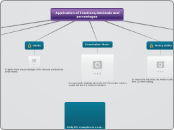Measurement and evaluation
measurement
Process of establishing the quantity of a property or characteristic with instruments
Topics
are
sampling
sampling types
Simple random sampling: A subset of the population is randomly selected to form the sample.
Stratified sampling: The population is divided into groups or strata, and a sample is selected from each stratum.
Cluster sampling: The population is divided into clusters, and some clusters are selected to form the sample.
Systematic sampling: An element from the population is selected, and then subsequent elements are chosen at a constant interval.
Convenience sampling: The most accessible or convenient elements are selected to form the sample
statistics
Descriptive statistics
It is a branch of statistics that is responsible for organizing, summarizing, and presenting data in an informative manner.
Inferential statistics
The performance of hypothesis testing is used to evaluate claims about the population based on the sample.
variable
quantitative variable
numerical values and can be measured or counted
qualitative variable
describes characteristics or attributes that cannot be measured numerically
data
is
Facts that are collected for analysis and can be textual or graphical are called data.
as
*surveys
*measurements
*records
*database
*Data analysis
*Patterns
*Decision making
*Data quality
*Data veracity
evaluation
Evaluating or interpreting measurement results involves analyzing the data obtained and understanding its meaning.









